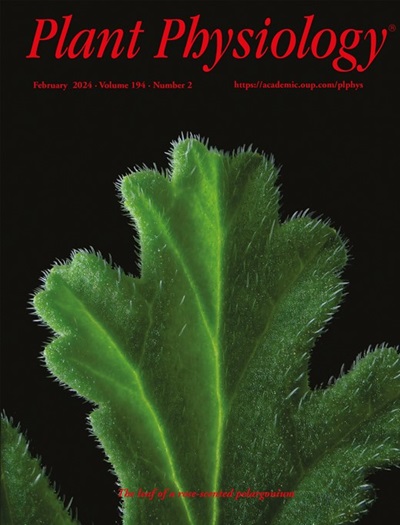乙烯insensitive2样蛋白介导了专利状乳胞的浸没和干旱反应
IF 6.9
1区 生物学
Q1 PLANT SCIENCES
引用次数: 0
摘要
乙烯不敏感2 (EIN2)是被子植物中一个Nramp家族跨膜蛋白,被认为是乙烯信号转导的重要组成部分。然而,其在其他植物系统中的功能尚不完全清楚。在这里,我们证明了苔藓Physcomitrium patens的ppein2ab突变体,其中两个ein2样基因都被破坏,在浸泡后不表现出典型的乙烯介导的逃逸反应。有趣的是,pepin2ab突变体对ABA(一种介导干旱胁迫反应的植物激素)的敏感性降低。ppein2ab植株对高渗和冰冻胁迫敏感,胚胎发育后期蛋白积累减少。此外,pein2ab突变体显示snf1相关蛋白激酶2 (SnRK2)的激活降低,SnRK2是ABA和渗透胁迫信号的中心激活因子,B3-RAF激酶ARK/PpCTR1L是SnRK2的正调节因子。这些结果表明,EIN2是苔藓植物中具有双重功能的信号成分,介导了淹没和干旱信号。通过引入拟南芥EIN2和Chara braunii的EIN2同源物,恢复了ppein2ab中ABA响应的减弱,表明EIN2同源物在phragmoplasophyta中具有功能保护作用。本文章由计算机程序翻译,如有差异,请以英文原文为准。
ETHYLENE INSENSITIVE2-like protein mediates submergence and drought responses in Physcomitrium patens
ETHYLENE INSENSITIVE 2 (EIN2) is an Nramp family transmembrane protein recognized as an essential component of ethylene signaling in angiosperms. However, its functions in other plant systems are not fully understood. Here, we demonstrate that ppein2ab mutants of the moss Physcomitrium patens, in which both EIN2-like genes have been disrupted, do not show a typical ethylene-mediated escape response following submergence. Interestingly, ppein2ab mutants showed reduced sensitivity to abscisic acid (ABA), a phytohormone that mediates drought stress responses. The ppein2ab plants were sensitive to hyperosmosis and freezing stress and exhibited reduced late embryogenesis abundant protein accumulation. Furthermore, ppein2ab mutants showed reduced activation of both SNF1-related protein kinase2 (SnRK2), the central activator of ABA and osmostress signaling, and the B3-RAF kinase ARK/PpCTR1L, a positive regulator of SnRK2. These results indicate that EIN2 is a dual function signaling component mediating both submergence and drought signaling in bryophytes. The diminished ABA responses in ppein2ab were restored by introduction of Arabidopsis EIN2 and the EIN2 orthologs of the Charophyceaen alga Chara braunii, suggesting functional conservation of EIN2 orthologs in Phragmoplastophyta.
求助全文
通过发布文献求助,成功后即可免费获取论文全文。
去求助
来源期刊

Plant Physiology
生物-植物科学
CiteScore
12.20
自引率
5.40%
发文量
535
审稿时长
2.3 months
期刊介绍:
Plant Physiology® is a distinguished and highly respected journal with a rich history dating back to its establishment in 1926. It stands as a leading international publication in the field of plant biology, covering a comprehensive range of topics from the molecular and structural aspects of plant life to systems biology and ecophysiology. Recognized as the most highly cited journal in plant sciences, Plant Physiology® is a testament to its commitment to excellence and the dissemination of groundbreaking research.
As the official publication of the American Society of Plant Biologists, Plant Physiology® upholds rigorous peer-review standards, ensuring that the scientific community receives the highest quality research. The journal releases 12 issues annually, providing a steady stream of new findings and insights to its readership.
 求助内容:
求助内容: 应助结果提醒方式:
应助结果提醒方式:


